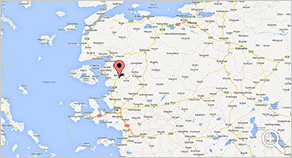PERGAMON

Pergamon is located in West Anatolia, 26 km from the Aegean Sea on a promontory on the north side of the river Bakırçay. It was an ancient Greek city and became the capital of the Kingdom of Pergamon during the Hellenistic period, under the Attalid Dynasty (282 BC-133 BC). After 133 BC, along with Ephesus, the Attalids were among the most loyal supporters of Rome in the Hellenistic world. Adjacent to the ancient settlement of Pergamon (Acropolis) in Kale Tepe (Castle Hill), there are many smaller and bigger mounds in the Plain of Bakırçay. According to surface studies in those mounds, the history of settlements in Bergama dates back to the early Bronze Age (3rd millennium BC).
The acropolis of Pergamon is situated 335m high on a hill, and was modeled after the one in Athens. On the upper city, it consists of a number of buildings such as Royal Palaces, the Temple of Trajan, the Sanctuary of Athena, the Arsenal, the Alter of Zeus, the Upper Agora, the Theater and the Library. The Library of Pergamon on the Acropolis is the second best in the ancient Greek civilization. When the Ptolemies stopped exporting papyrus, partly because of competitors and partly because of shortages, the Pergamenes invented a new substance to use in codices, called “pergaminus” or “pergamena” (parchment) after the city. It was made of fine calfskin, a predecessor of vellum. The Alter of Zeus is now in the Pergamon Museum in Berlin, but the base of the alter remains on the Upper part of the Acropolis. The Lower city includes the Gymnasium, the Temple of Demeter, the Sanctuary of Hera, the House of Attalus, the Agora and the Gate of Eumenes.
The Asclepion, the Sanctuary of Asclepius, lies 3 km south of the Acropolis, down in the valley. Dedicated to Asclepius, the god of medicine and healing, the Asclepion was a healing temple in Ancient Greece, as important as its counterparts in Epidaurus and Kos. According to Pausanias, the first Temple of Asclepius in Pergamon was built in the first half of the 4th century BC on the slopes of Mount Geyikli, inside a hidden valley far away from the city, whose springs were believed to have healing effects. Prehistoric remains, unearthed during excavations at the site of the Asclepion, indicate that this area had been used before 4th century BC. Treatment methods implemented in this sacred area, which took its final shape during the reign of Emperor Hadrian (117-138 AD), and physicians such as Galen, became very famous, especially in the Roman Period. There is a Roman bazaar street, once lined with shops, which led to the Ascleption's entrance. Inside, there are fine, upright columns, ruins of a library, temple and theatre. It was said that in these rooms, patients dreamt and received prognoses through Asclepios, the god of medicine.
Pergamon's other notable structure is the great temple of the Egyptian gods Isis and/or Serapis, and also Osiris, Harpocrates and other lesser gods, known today as the "Red Basilica", about 1 km south of the Acropolis. It consists of a main building and two round towers within an enormous temenos, or sacred area. In the first century AD, the Christian Church at Pergamon inside the main building of the Red Basilica was one of the Seven Churches to which the Book of Revelation was addressed. The forecourt is still supported by the 196 m wide Pergamon Bridge. Byzantines converted the temple into a Christian church dedicated to St John, but was subsequently destroyed.
In 1878, Pergamon was first excavated by Germans Carl Humann, Alexander Conze, and R. Bohn. In 1876, Humann was in charge of the Istanbul-Izmir railroad, when a worker brought him a fragment of the frieze from the Pergamon site. Humann took the artifact to Conze, a museum curator in Berlin, who recognized its importance, and the Ottomans granted permission to excavate in 1877. The German Institute of Archaeology took over the excavations in 1900, and the excavations have continued to the present day, interrupted only by the two World Wars. In 1932, Marshal Fevzi Çakmak visited Bergama and ordered to found a museum. The museum project, which was made by architects Bruno Meyer and Harold Hanson, completed in 1932, and began building in the next year at the request of Kazım Dirik, Governor of Izmir. In 1936, the Bergama Museum was opened to the public by the Governor of Izmir, Fazlı Güleç.
World Heritage List: Pergamon and its Multi-Layered Cultural Landscape
Some selected examples (please click on pictures to enlarge):









